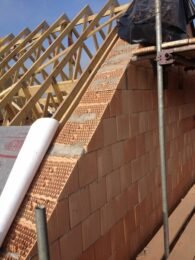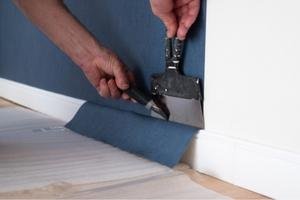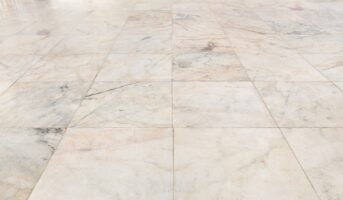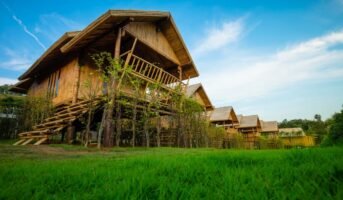Clay bricks with horizontal or vertical perforations are called porotherm bricks. The materials used to make them are natural clay, coal ash, rice husk, and granite slurry. The most typical dimension is 400x200x200 mm. This sort of brick is referred to as porotherm because of its intended thermal insulation properties.
The clay brick’s perforation offers an exceptional walling system that enables thermal insulation, resulting in lower interior temperatures in the summer and warmer interior temperatures in the winter.
Both load-bearing and non-load-bearing walls may be constructed using the porotherm clay bricks since they are adaptable, reasonably priced, and environmentally benign. The porotherm bricks offer a high level of fire resistance while being lightweight and durable. It may be applied using dry mortar, which does not require curing.

Source: Pinterest
Porotherm bricks: Properties
Porotherm bricks are a type of clay brick commonly used in construction. Here are some of the properties of Porotherm bricks:
- Durability: Porotherm bricks are durable and can withstand harsh weather conditions, making them suitable for use in a variety of climates.
- Strength: Porotherm bricks are known for their high strength, making them ideal for use in load-bearing walls.
- Insulation: Porotherm bricks have good insulation properties, helping to regulate the temperature inside a building and reduce energy consumption.
- Fire resistance: Porotherm bricks are fire-resistant, providing an added layer of safety in the event of a fire.
- Water resistance: Porotherm bricks are resistant to water damage, making them suitable for use in areas with high levels of moisture.
- Sustainability: Porotherm bricks are made from natural materials and are recyclable, making them an environmentally friendly option for construction.
- Cost-effective: Porotherm bricks are relatively inexpensive compared to other building materials, making them a cost-effective option for construction.
- Workability: Porotherm bricks are easy to work with and can be cut, drilled, and shaped to meet the specific needs of a construction project.
These are some of the key properties of Porotherm bricks, but the specific properties may vary depending on the manufacturer and the type of brick.

Source: Pinterest
Porotherm bricks’ benefits
Strengthening
Porotherm brick has a compressive strength more than 3.5MPa. The material has exceptional strength due to the use of high temperatures during production and the inclusion of terracotta material.
Thermal Insulation
Since the bricks are perforated, Porotherm bricks provide excellent heat insulation.
High Resilience
The great compressive strength, fire resistance, and carbonation resistance of porotherm bricks make them extremely robust and long-lasting. The danger of moisture, fissures, or shrinking of walls is extremely minimal due to the 15% water absorption rate.
Economical
The porotherm bricks not only save a lot of energy, but they also lower construction and maintenance costs. By employing this kind of brick, you wouldn’t need an air conditioner in the summer or a heater in the winter, saving energy. Because it doesn’t use sand or cement to build walls, it lowers building costs. Finally, it requires no upkeep.
Ecologically friendly
There is recycled material in the porotherm bricks. It wouldn’t trigger allergic reactions because chemical components aren’t employed in its construction.
Construction Speed
When porotherm bricks are utilised, the wall construction pace is significantly increased. This is because porotherm brick walls may be built without the need for sand or cement, making the bricks lightweight, manageable, and curing-time-free.
Furthermore, it is simple to cut and chisel, which makes installing fixtures much simpler. Last but not least, porotherm ensures a clean and dry work environment, leaving no detritus to be disposed of.
Porotherm bricks: Drawbacks
- The density of Porotherm Clay Bricks, which ranges from 694 to 783 kg/m3, prevents their application in the construction of large constructions.
- Due to its 15% water absorption, it may be vulnerable to salt assaults, which would reduce the structure’s strength.
- In regions with a high groundwater table, porotherm bricks cannot be utilised for base-slab construction or foundation work. This is due to the possibility that such bricks won’t be able to endure water’s negative pressure and capillary action.

Source: Pinterest
Porotherm bricks: Applications
Porotherm bricks are a type of clay brick commonly used in construction for the following purposes:
- Building walls: Porotherm bricks are often used in the construction of walls for houses, commercial buildings, and other structures due to their strength and durability.
- Load-bearing walls: Due to their high strength, Porotherm bricks are often used in the construction of load-bearing walls that support the weight of a building.
- External walls: Porotherm bricks are often used in the construction of external walls, where they provide insulation, fire resistance, and protection against the elements.
- Partition walls: Porotherm bricks are also used in the construction of partition walls, where they provide sound insulation and privacy.
- Fireplaces and chimneys: Porotherm bricks are used in the construction of fireplaces and chimneys due to their fire-resistant properties.
- Landscaping: Porotherm bricks can also be used for landscaping purposes, such as creating retaining walls, garden beds, and other structures.
These are some of the common uses of Porotherm bricks, but the specific use may vary depending on the needs of a construction project and the requirements of local building codes.
Porotherm bricks: What makes them different?
Porotherm bricks are a type of clay brick that is different from other types of bricks in several ways:
- Manufacturing process: Porotherm bricks are made using a vacuum extrusion process that compacts the clay mixture and results in a dense, uniform brick with consistent properties. This process makes Porotherm bricks stronger and more durable than other types of bricks.
- Thermal insulation: Porotherm bricks have good thermal insulation properties due to the unique manufacturing process and the use of high-quality raw materials. This makes them an energy-efficient option for construction.
- Strength: Porotherm bricks have high compressive strength, making them ideal for use in load-bearing walls.
- Sustainability: Porotherm bricks are made from natural materials and are recyclable, making them an environmentally friendly option for construction.
- Workability: Porotherm bricks are easy to work with and can be cut, drilled, and shaped to meet the specific needs of a construction project.
- Appearance: Porotherm bricks have a distinctive, uniform appearance that makes them a popular choice for use in modern construction projects.
FAQs
What are Porotherm bricks made of?
Porotherm bricks are made of a mixture of clay and other natural materials, such as sand and water. The clay mixture is moulded into the desired shape and then fired in a kiln to harden the brick.
What are the benefits of using Porotherm bricks in construction?
Porotherm bricks offer several benefits, including high strength, good insulation properties, fire resistance, water resistance, sustainability, cost-effectiveness, and ease of workability.
How are Porotherm bricks different from other types of bricks?
Porotherm bricks are different from other types of bricks in several ways, including the manufacturing process, thermal insulation, strength, sustainability, workability, and appearance.
Housing News Desk is the news desk of leading online real estate portal, Housing.com. Housing News Desk focuses on a variety of topics such as real estate laws, taxes, current news, property trends, home loans, rentals, décor, green homes, home improvement, etc. The main objective of the news desk, is to cover the real estate sector from the perspective of providing information that is useful to the end-user.
Facebook: https://www.facebook.com/housing.com/
Twitter: https://twitter.com/Housing
Email: [email protected]











